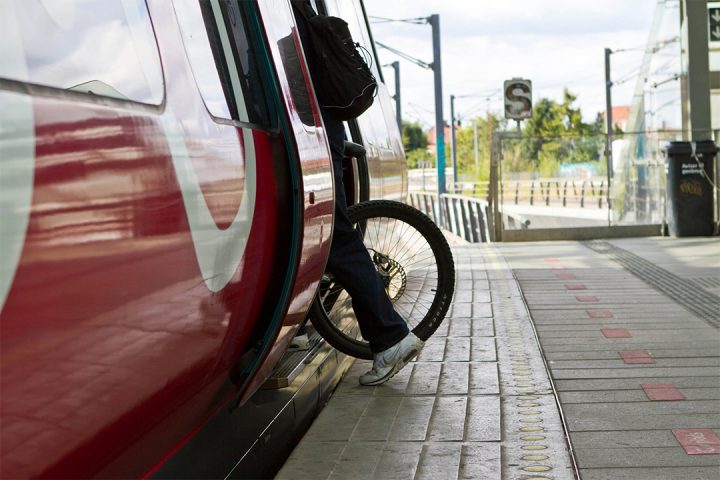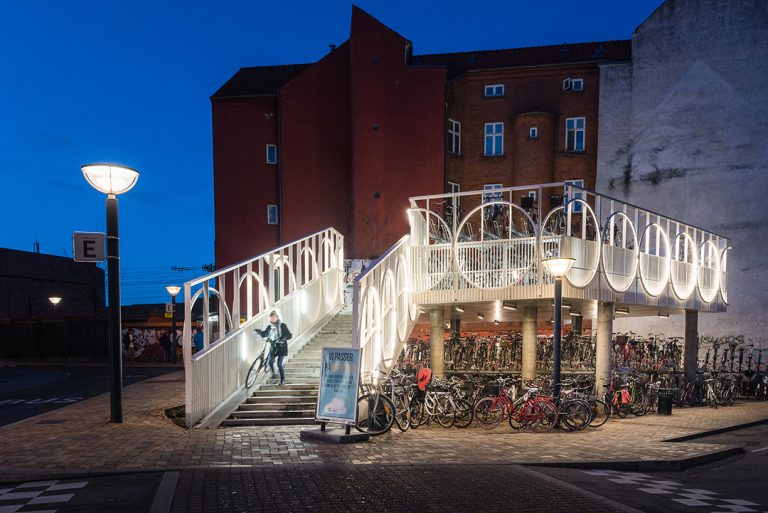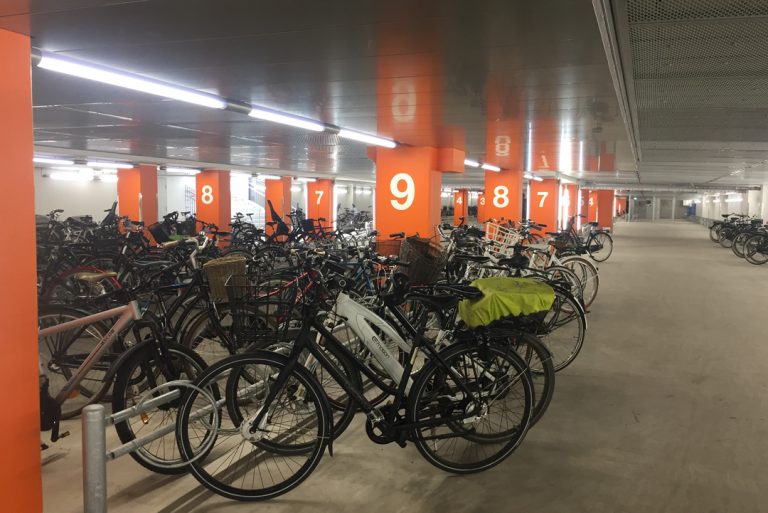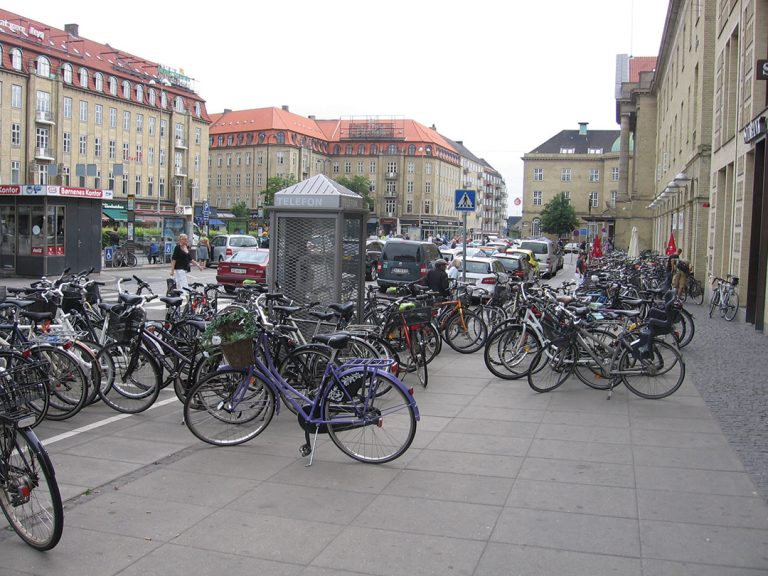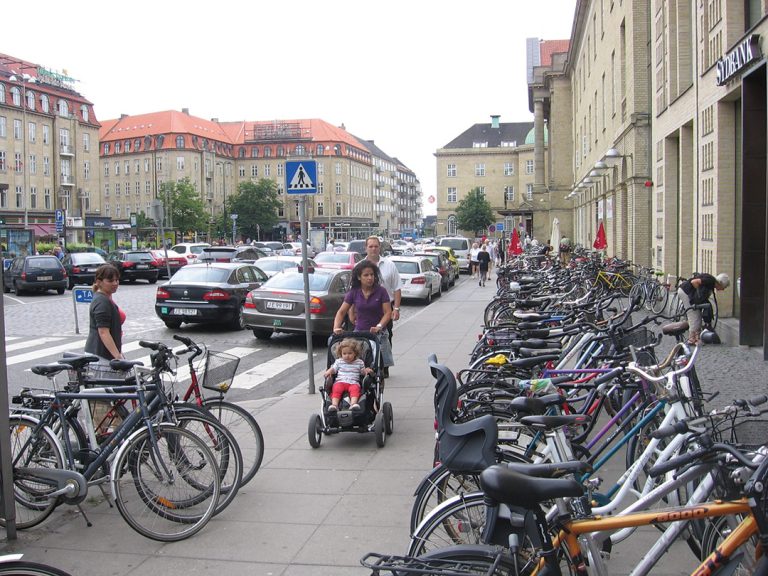Bike plus train –an attractive model
The combination of bikes and trains is attractive, and means you can cycle even if there’s a long way to go between home and work. However, the interplay of many factors determines whether the combination is competitive. In Denmark cities like Odense have shown what good bicycle parking facilities can mean, and the fact that in Copenhagen, for example, bikes are allowed for free on S- trains has encouraged many people to combine the bicycle with collective transport.
By Andreas Røhl & Anne Severinsen, Gehl Architects
Many people combine trains and bicycles
More than one third of train trips with a connection to Copenhagen take place in combination with a cycle trip at one or both ends of the train trip. Almost 30% cycle between their homes and the station, and 10% cycle between the station and the destination. The bike-train combination is most frequent on trips to and from work. The bicycle/train combination is also widespread in other parts of Denmark. The equivalent figures are 20% and 5% respectively. The typical cycle trip to and from the station is one to three kilometers.
The factors that are significant in determining the extent of bicycle/train trips can be divided into three categories:
- Railway factors (the quality of train traffic including travel time, frequency, reliability, and comfort.)
- Context factors (culture, including the local status of cycling, demography, etc.)
- “First/last mile” factors (the quality of the cycle link to and from the station, the bicycle parking facility at the station, etc.
In Denmark cycling is considered normal or mainstream. Context factors consequently present relatively few barriers to cycling to the train. Railway service in Denmark isn’t up to Swiss standards, but is still quite good, and is competitive between the larger cities as well as in and around Copenhagen.
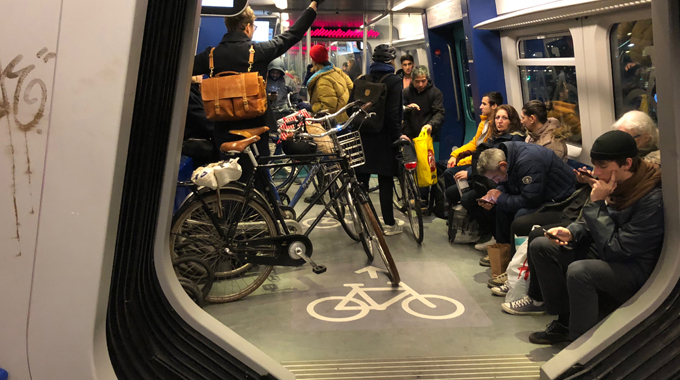
- S- train, capital region of Denmark/ Gehl Architects
Better options for combining bikes and trains have an impact
Bikes have been allowed for free on the regional train system in and around Copenhagen (the S-train) since 2010, and this has had an impact: around 14% of all S-train travelers and 20% of Copenhagen residents commuting out of Copenhagen by S-train today use the bicycle at the destination end. These are high figures, and they are higher than the equivalent figures for other types of train. They are also higher than Utrecht, Holland where the equivalent figure is approx. 10%. The effect is not only that more people cycle to and from the station, but also that new train trips are created.
The fact that free bicycles on S-trains has had a significant impact indicates that there is an enormous latent potential for increasing cycling at the destination end if cycling access at the destination end is friction-free.
Distribution of connecting transport mode to/from trains for trips in relation to Copenhagen (to and from home):
Walking: 49%
Cycle: 27%
Car: 8%
Bus: 16%
Distribution of connecting transport mode to/ from trains for trips in relation to Copenhagen (to and from destination):
Walking: 75%
Cycle: 10%
Car: 3%
Bus:11%
The distribution of connecting transport mode to and from train trips in relation to Copenhagen (the City of Copenhagen and Frederiksberg Municipality) are based on Center for Transport Analytics data for trips on the home end and trips on the destination end of the train trip, respectively: Transportvaneundersøgelsen, TU, 2010-2016
On other types of train in Denmark today, you need a bike-ticket for the Copenhagen Metro and regional trains, but reservations are unnecessary (although bikes are not allowed on the Metro during peak hours). Bicycles are allowed on Intercity trains with a reservation. The bicycle capacity on this type of train is fairly limited, but the smallest folding bikes are considered hand luggage. Bicycles are allowed on Aarhus light rail outside peak hours, and cycles will be allowed on the coming light rail in Odense at all times.
Bicycle parking at stations
Countries such as Germany, Switzerland and Holland are ahead of Denmark when it comes to the quality of bicycle parking at stations. However there are also good examples in Denmark.
One of them is Odense Station Center. It was decided to install many different types of parking solutions which would supplement each other, from locked basement parking to uncovered parking on street level, and everything in between. The result is good access from all sides of the station, sufficient capacity, and the individual user can choose the solution that suits him best. Frequent tidying up of abandoned bikes and bicycles outside the parking facility help create good conditions and a pleasant urban space.
Other stations have a central bicycle parking facility. An example of this is Lyngby Station north of Copenhagen where a spacious bicycle basement with good access roads is the primary parking facility. For further information on bicycle parking see the following article on bicycle parking.
- Odense Station Center, Odense /Thomas D. Mørkeberg
- Lyngby Station, Copenhagen /Gottlieb Paludan Architects
- Aarhus Station, Aarhus /CED 2012
- Aarhus Station, Aarhus /CED 2012
“It just takes five minutes”. Pictures taken before and after tidying up illustrate how the combination of accessible bicycle parking and effective tidying up ensures good accessibility and a pleasant urban space for everyone around the station.
The spread of bike-sharing
The world’s first modern bike- sharing system started in Copenhagen in 1995. Since then city bikes (shared bikes) have undergone a tremendous transformation, and other cities and countries have overtaken Copenhagen and the rest of Denmark. However, there is a continued focus in Denmark on improving access to bike -sharing at stations. These three types of bike share, for example, are currently operational:
- Traditional bike -share systems based on outdoor advertising, for example in Odense.
- “The city bike” in Copenhagen, funded by the local authorities, DSB, and user fees.
- Market- based free floating systems, primarily Donkey Republic, which operate in a number of larger Danish cities.
All three types require permission from the local authority to operate on public roads.
Scooter-sharing systems have also become popular, also for trips to and from stations. However, scooter sharing is such a new concept that it’s too early to say whether it will have a noticeable impact on transport habits, including the use of bicycles to and from stations.
The bike-train combination and journey planning tools
In recent years there has been a focus on integrating the bike-train combination into various digital journey planners. This is essential, partly as a practical device, and partly as a means to communicate the competiveness of the bike-train combination in relation to other transport modes when it comes to travel times.
Cycling connections to and from stations
Regardless of how easy it is to bring bikes on trains or rent bicycles at stations, it’s to no avail if cycling conditions to and from the station are not satisfactory. For information about the work of creating a good network of cycle connections see the articles on planning and designing the cycling infrastructure.
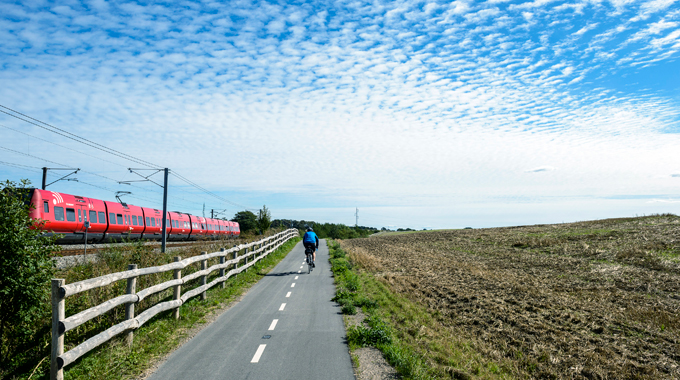
- Cycle superhighway along S- train, Cycle superhighways, capital region of Denmark
The bike-bus combination
The bike-bus combination also has potential, especially express and long distances busses. The Movia bus company has drawn up guidelines for good bicycle parking facilities at bus stops. (See “Superskiftet – en guide til gode skifteforhold mellem cykel og bus”
Bikes are often allowed on busses or on a bike rack mounted on the bus. In Odense bikes are allowed on city busses outside peak hours.
Cycle superhighways and trains in the capital region of Denmark
Cycling for long distances is common on the cycle superhighways. The average trip is approx. 15 kilometers on many routes. The routes are coordinated with the S- train network so there is easy access at stations. This ensures an excellent connection between bicycles and trains. Travelling becomes more flexible since travelers can cycle out and take the train home, or they can cycle a bit further to a station with better connections if they don’t want to change trains, or if it starts to rain they can just hop on the train. In other parts of the country the cycle trip can typically be combined with the local railway stations.
Sources:
- Superskiftet – en guide til gode skifteforhold mellem cykel og bus, Movia (2017)
- Undersøgelse af overflytningspotentialet til supercykelstierne og kombinationsrejser samt samspillet mellem cyklen og det kollektive”, Megafon (2018)
- Potentialet for cykeltog kombinationsrejser i hovedstadsområdet, Gehl & MOE,
- ”Undersøgelse af cykelparkering / Vaner og adfærd ved cykelparkering i byen”, Rambøll for Københavns Kommune (2015).
- ”Idékatalog for cykeltrafik”, Cycling Embassy of Denmark (2012).
- ”Bedre samspil mellem cyklen og den kollektive trafik, Idekatalog”, Trafikstyrelsen (2009).
- ”Cykelparkeringshåndbog”, Celis Consult og Dansk Cyklist Forbund (2007).


